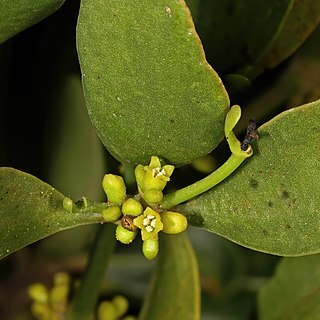Leafy, dioecious, hemiparasitic shrub, ± 1 m high, sometimes glaucous, pale green; internodes rounded; nodes often dilated. Leaves oblanceolate-obovate, 3-nerved basally. Staminate flowers in sessile, axillary dichasia, 2 or 3 per axil. Pistillate flowers solitary in bracteal cups, and then borne singly, or in fascicles of 2 or 3 per axil. Flowering time June, July. Fruit an ellipsoid-globose berry, whitish cream-coloured to pale pink, smooth, developing a relatively long stalk at maturity.
Leafy, dioecious shrub, up to 1 m high, parasitic on numerous hosts like species of Acacia, Manilkara. Leaves oblanceolate-ovate. Persistent style on mature fruit 1 mm long. Berries white at maturity, 6-7 mm long, pedicel 3-6 mm long. Flowers yellowish green.
Dioecious stem parasite to 1 m. Leaves oblanceolate, 3-veined from base. Inflorescences unisexual. Berries pedicellate, smooth, cream-coloured to pale pink.


